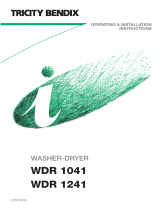
14
DYED COTTON
Laundry made of dyed cotton which is to be washed
at 60 °C should be fi rst washed at a temperature of
60 °C to remove the excess dye. If this is not done,
there is danger of dye being washed out of such
items. To maintain the colour of the fabric, use
bleach-free detergent.
UNBLEACHED LINEN
Unbleached lining fabric should be washed at
60 °C with a detergent free of bleach or optical
bleaching agents. Heavily soiled linen laundry may
be occasionally washed at higher temperatures, but
do not do this too often as heat could ruin the sheen
and strength of linen clothing.
WOOL
These fabrics are intended for either machine or
hand wash. The Wool/Hand Wash program is
equally gentle or even gentler than an actual hand
wash.
Wool in particular is sensitive to washing and similar
procedures.
If you do not wish to spin your clothes, select a
setting without spinning (see "STEP 6: Choose
the program settings /button 3"). However, most
garments are suitable for at least a short spinning
cycle. Top spinning speed available is 800 rpm.
VISCOSE AND SYNTHETIC FIBRES
Materials made of viscose and some synthetic fi bres
are highly sensitive, and require a lot of space in
order not to crease. When washing, only fi ll the
drum to a half and choose a program with spinning
speed of no more than 1,000 rpm.
Viscose and acetates are fragile when wet.
REDUCING ALLERGIC REACTIONS
(Only in some models)
The options include washing with the Allergy
Program Cotton and Allergy Program Synthetics,
using the Allergy Mode program setting, or using an
extra rinse (Super Rinse). These programs, program
settings, and functions can be used for people
with sensitive skin, such as those suff ering from
allergies, or small children.
SAVING TIME AND ENERGY
To save time and energy, use the Everyday Wash.
This program has shorter main wash cycle than
Standard Cotton and often suffi ces for less soiled
laundry.
ECONOMY AND EFFICIENCY
You can save a lot of energy by not using the
programs operating at higher temperatures.
Choose the Quick program if you wish to only
refresh the laundry; or use the Time program. This
will save water and power.
Selecting the maximum spinning speed will reduce
power consumption if you dry the clothes in a
dryer or a drying cabinet.
When using the programs Heavy, Everyday Wash
and Standard Cotton, we recommend washing a full
load.
Avoid prewash. Modern washing machines and
detergents are effi cient without the prewash as well.
Prewash is only necessary for heavily soiled
laundry. Use the additional function Prewash (see
"STEP 6: Program Settings Menu – choosing extra
functions / button 5").
DETERGENTS
Detergents carrying the environment protection label
are less harmful to the environment.
Only add the detergents in compliance with the
recommendations by detergent manufacturers.
Recommended amount of washing detergent
at certain loads and water hardness levels are
specifi ed on the detergent packaging.
STAINS
If your clothes are soiled with stubborn stains
(blood, eggs, coff ee, grass etc.), they should be
appropriately treated before the wash. Then, wash
your laundry using the special programs (if your
washing machine has them).
Do not use any chemical substances or agents;
only use the stain removing detergents.
DYEING FABRICS
If you wish to dye fabrics in the washing machine,
choose the Everyday Wash program with the Super
Rinse extra function. Choose the temperature
according to the dye manufacturer's
recommendations. If you dye mixed fabrics, such
as polyester/cotton, choose a low spinning speed.
Add the dye directly into the drum, rather than
in the detergent compartment. After dyeing use
the Drum Cleaning program (self-cleaning program).
Use the standard amount of detergent.
When using bleaches or stain removal agents,
there is danger of corrosion and discolouration.
To protect the environment, we recommend you
avoid using powerful chemicals.




















